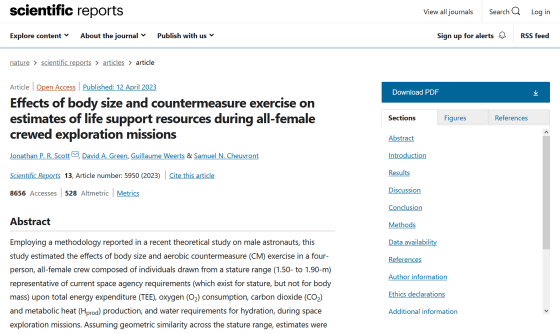Clearly female astronauts are more efficient than men in terms of necessary food and oxygen

Effects of body size and countermeasure exercise on estimates of life support resources during all-female crewed exploration missions | Scientific Reports
https://dx.doi.org/10.1038/s41598-023-31713-6

Study finds female astronauts more efficient, suggesting future space missions with all-female crews
https://phys.org/news/2023-05-female-astronauts-efficient-future-space.html
Long-term missions, such as the exploration of Mars, also require space and fuel to transport commodities such as water, food, and oxygen to sustain life for participating astronauts. Therefore, thinking about ``what kind of astronauts can be selected to improve energy efficiency?'' has important implications for future space exploration missions.
The ESA research team estimated the amount of hydration, total energy expenditure, oxygen consumption, carbon dioxide emissions, and metabolic heat production necessary for survival of astronauts on long-term space exploration missions for men and women, respectively. Analyzed.
Estimates of the effect of body size on life support requirements show that female astronauts require less water, total energy expenditure, and oxygen consumption than male astronauts of the same height. turned out. In other words, it turned out that female astronauts are more energy efficient in space exploration than male astronauts, even if they are the same height.

According to the research team, total energy expenditure is 5-29% lower for women than men for the same height, and the reduction rate is 11-41% when comparing the median values of American women and men. It is said that it will be reached. This also affects oxygen consumption, carbon dioxide output and metabolic heat production.
Astronauts must exercise regularly to prevent muscle and bone deterioration in the microgravity of the International Space Station. The larger the body, the more energy is required, and the more oxygen, water, and food consumed, but women can also reduce these consumptions more than men.
Calculations show that if all four members of the International Space Station are women, the total food weight required for a long-term mission of 1080 days can be reduced by a total of 1695 kg. According to NASA, the cost of transporting luggage to the International Space Station is 93,400 dollars (about 13 million yen) per kg, and the cost of the mission is about 158 million dollars (about 22 billion yen) You may save.

by
Excess food is not only a burden as weight, but also physically presses the space inside the International Space Station. If the necessary food can be reduced by 1695 kg in weight, 2.3 m 3 of space can be released. This is about 4% of the habitable volume of the International Space Station, which is 60m 3 .
In a narrow space such as the International Space Station, it is necessary to devise ways to allow multiple astronauts to work together. It has been.
'These data, coupled with the shift to smaller diameter space habitation modules, suggest that there may be operational advantages to having an all-female crew during future human space exploration missions,' the researchers said. It suggests that there is a

Related Posts:
in Science, Posted by log1h_ik







